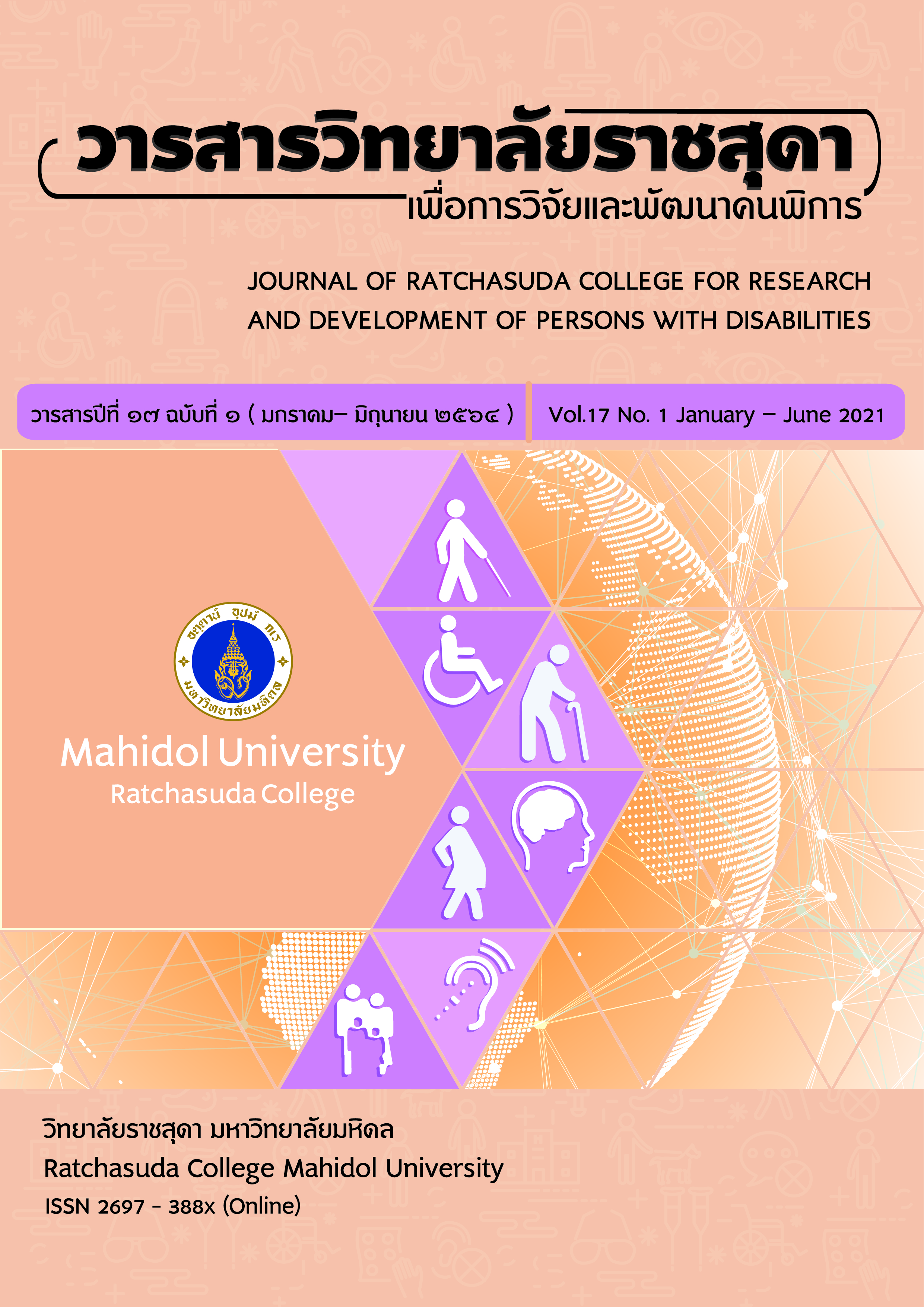The Development of Information Service of School Library for Children with Special needs in Mainstreaming to Enhance 21st Century Learning Skills
Keywords:
Information Service, School Library, Children with Special needs in Mainstreaming, 21st Century Learning SkillsAbstract
The objectives of this research were 1. to study the condition and need of information service of school library for children with special needs, 2. to develop information service, 3. to study the opinions on the development of information service, and 4. to study the effect of information service of school library for children with special needs in mainstreaming to enhance 21st century learning skills. The results of the study were as follows: 1. the condition of information service of school library for children with special needs was at the level of “average”, and the need of information service was at the level of “high”. 2. The information service of school library for children with special needs composed of 5 components; 1) management of information service of school library for children with special needs, 2) personnel and staff of information service of school library for children with special needs, 3) information resources, 4) instructional strategy and activity, 5) evaluation and feedback. The activity composed of 6 steps; 1) breaking the ice to get ready, 2) reading digital for learning, 3) information literacy, 4) media literacy, 5) technology literacy, 6) presentation, summarization, and feedback. 3. The opinion on information service was at the level of “high”. 4. The satisfaction on the information service of school library for children with special needs found that the overall opinions were at a high level, the average score of 6.84, which gained the 60% criteria.
Downloads
References
Dechakup, P. & Yindeesuk, P. (2015). Learning management in the 21st century. (2nd ed.). Bangkok: Chulalongkorn University Printing House.
EBSCO. (2015). 7 Best practices for creating a user friendly library website. [Online]. Available: https://www.ebsco.com/blog/article/7-best-practices-for-creating-a-us. [2018, May 19].
EBSCO. (2017). Advocacy and the 21st century school librarian: Challenges and best practices. [Online]. Available: https://www.ebsco.com/blog/article/advocacy-and-the-21st-century-s school-librarian-challenges-and-best-practice. [2018, June 16].
Grant, M. M. (2002). Getting a grip on project-based learning: theory, cases and recommendation. Meridian: A Middle School Computer Technology Journal. 5(1), pp. 65-97.
International Federation of Library Associations and Institutions. (2015). IFLA school library guideline. IFLA.
JISC. (2010). Quick guide-developing students’ digital literacy. [Online]. Available: https://digitalcapability.jiscinvolve.org/wp/files/2014/09/JISC_REPORT_Digital_
Literacies_280714_PRINT.pdf. [2018, May 19].
Luechaipanich, V. & Chimpara, K. (2016). Futuristic classroom turns a teacher into a coach. Bangkok: SE-ED Public Company Limited.
National Institute of Education Testing Service. (2015). National basic educational testing result (O-Net) academic year 2015. [Online]. Available: http://www.onetresult.niets.or.th/AnnouncementWeb/PDF/SummaryONETP6_2558.pdf. [2016, April 19].
National Statistics Office Thailand. (2015). The results of the 2015 reading behavior survey. Bangkok: National Statistics Office Thailand.
Netwong, T. (2015). Information provider. Bangkok: Suan Dusit University.
Netwong, T. (2018). Instructional creation media project based for mainstreaming of undergraduate students to enhance 21st century learning. International Journal of e-Education, e-Business, e-Management and e-Learning. 8(4) December, pp. 227-233.
Netwong, T. (2019a). The school library roles in information services through mainstreaming for enhance 21st century learning skills. International Journal of Information and Education Technology. 9(2) February, pp. 154-158.
Netwong, T. (2019b). The using of inquiry and creativity-based learning to effectiveness digital literacy of mainstreaming students, library and information science program. RMUTI JOURNAL, Humanities and Social Sciences. 6(1) January-June, pp. 83-97.
Nimtalung, O. (2009). Inclusive education: Access to education for all. Sakon Nakhon Rajabhat University Journal. 1(2), pp. 39-53.
Office of the Basic Education Commission. (2013). School library standards. Office of the Basic Education Commission, Ministry of Education.
Office of the Education Council. (2017). National education plan 2017–2036. Office of the Education Council, Ministry of Education.
Ontario School Library Association. (2010). Together for learning: School libraries and the emergence of the learning commons. Ontario: Ontario School Library Association.
Phosaard, S. (2016). Grand challenges in digital university. Suranaree J. Soc. Sci. Vol. 10. No. 2. December. pp. 171-188.
Phukabkhao, P. (2010). The proposed policy for the effectiveness of inclusive schools in Khon Kaen province. Doctor Philosophy Thesis in Educational Administration, Graduate School, Khonkaen University.
Prueksununt, P., Supapongpichate, R. & Buawatana, M. (2011). Community participatory learning process for livable city development, Pranburi Subdistrict, Municipality, Prachuap Khiri Khan province. Bangkok: Department of Health, Health Center 4.
Special Education Bureau. (2015). 1st Report of the international conference on special education. Office of Special Education Services, Office of the Basic Education Commission. Ministry of Education.
Thailand Knowledge Park. (2013). Read him read us. Bangkok: Office of Knowledge Management and Development.
Trilling, B. & Fadel, C. (2009). 21st century skills: learning for life in our times. San Francisco: Jossey-Bass.
Udompiriyasak, S. (2010). The development of the administrative service center model for disabled students mainstreaming of higher education. Dissertation of Education (Education Management). Suan Dusit Rajabhat University, Bangkok, Thailand.
Wongkorm, K. (2010). Knowledge of special education. Bangkok: Service and Supply.
Downloads
Published
How to Cite
Issue
Section
License
บทความที่ได้รับการตีพิมพ์เป็นลิขสิทธิ์ของวารสารสถาบันราชสุดาเพื่อการวิจัยและพัฒนาคนพิการ






